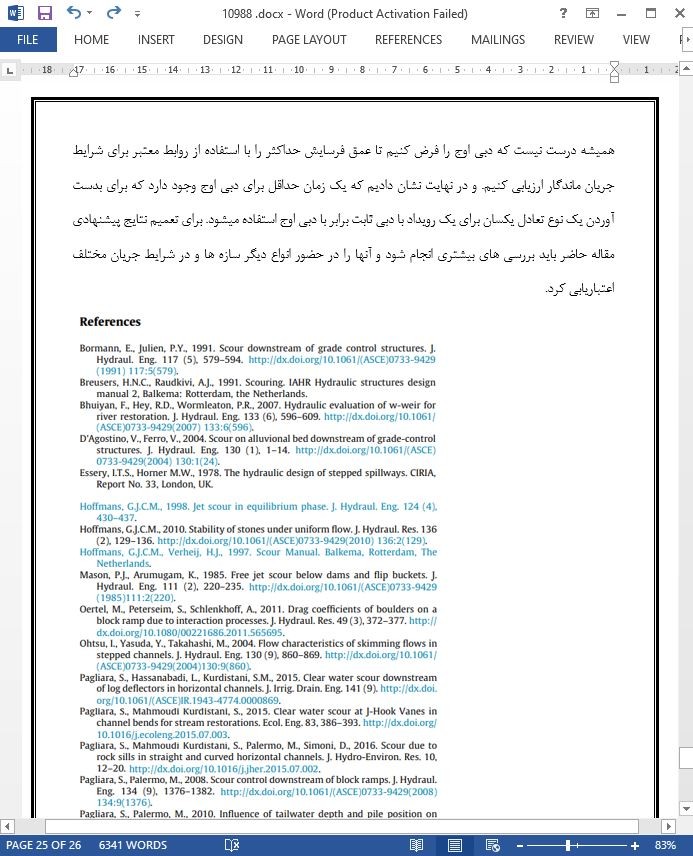
تاثیر شرایط جریان غیرماندگار بر روی ویژگی های فرسایش در سازه های هیدرولیکی کم ارتفاع
چکیده
مطالعه جریان پایین دست مکانیزم فرسایش سازه های کنترل کم ارتفاع، یکی از موضوعات اساسی برای مهندسان هیدرولیک است. عموماً تحلیل فرآیند فرسایش تحت شرایط جریان ماندگار انجام میشود و فرض میشود که دبی حداکثر برای زمان کافی رخ میدهد تا به شکل بندی فرسایش متعادل برسیم. با اینحال در رودخانه ها فرآیند فرسایش معمولاً در تطابق با وقوع سیل رخ میدهد، که این با دبی متغیر زمانی توصیف میشود. شرایط آخر هنوز به اندازه کافی از لحاظ تأثیرات آن بر روی نوع بستر مطالعه و تحلیل نشده است. محققان عمدتاً بر حداکثر عمق فرسایش تمرکز میکنند و فرض میکنند که این در تطابق با دبی اوج (آبگذری اوج) رخ میدهد اما آنها بندرت تکامل فرآیند فرسایش در شرایط جریان غیرماندگار را بررسی میکنند. هدف مقاله حاضر این است که تکامل نوع فرسایش را در شرایط جریان غیرماندگار تحلیل کند و آنرا با تکامل نوع فرسایش در شرایط جریان ماندگار مقایسه نماید. ما خصوصاً سه نوع سازه ای را آزمایش میکنیم: یک سرریز تور سنگی پله ای با لایه فیلترکننده غیر قابل نفوذ بالا دست، یک آستانه سنگی مستقیم، و یک آستانه سنگی منحنی شکل. نتایج نشان داد که پدیده فرسایش شدیداً به شرایط جریان ورودی وابسته است. همچنین مشخص شد که نوع تعادل حوضچه آرامش پایین دست، ضرورتاً در شرایط جریان ماندگار و غیرماندگار یکسان خواهد بود اگر مدت زمان رویداد غیرماندگار به اندازه کافی طولانی باشد.
1. مقدمه
مکانیزم فرسایش که در پایین دست سازه های کنترل کم ارتفاع رخ میدهد موضوع مهمی است که در دهه های اخیر بصورت گسترده مورد تحلیل قرار گرفته است. این تحلیل عمدتاً بر هیدرولیک و خصوصیات فرسایش در حوضچه آرامش متمرکز است. اثبات شده است که سازه های کم ارتفاع در کنترل انتقال رسوب مؤثر هستند و در عین حال قادر هستند که کاهش تأثیر بر روی اکوسیستم را تضمین کنند. بنابراین بسیاری از سازه های سنتی مجدداً به کارهای بی ضررتر برای محیط زیست (مانند رامپ های بتنی، سازه های کنترل سنگی درجه ای، سرریزهای تور سنگی پله ای، تیغه های متقاطع و غیره) تبدیل شده اند.
4. نتیجه گیری
ما در مقاله حاضر تأثیر موجود بر روی عمق فرسایش حداکثر شرایط جریان ورودی را تحلیل کرده ایم. در واقع این تحلیل هم در حضور سرریزهای تور سنگی پله ای و هم در حضور آستانه های سنگی انجام شده است. ما آزمایشات مرجع در شرایط جریان ماندگار را انجام دادیم تا مقادیر مرجع عمق فرسایش حداکثر را بدست آوریم که در حوضچه آرامش پایین دست رخ میدهد. همان آزمایشات را در شرایط جریان غیرماندگار تکرار کردیم. هیدروگراف اتخاذ شده برای شبیه سازی شرایط جریان غیرماندگار توسط یک فاز دبی توصیف شد که مدت زمان آن دو برابر مدت زمان فاز دبی افزایشی بود.
Abstract
The study of scour mechanism downstream of low-head control structures is a fundamental topic for hydraulic engineers. Generally, the analysis of the scour process is conducted under steady flow conditions, assuming that the maximum discharge is occurring for sufficient time to reach the equilibrium scour configuration. Nevertheless, in rivers the scour process generally occurs in correspondence with a flood event, which is characterized by discharge varying with time. This last condition is still less studied and analyzed in terms of effects on bed morphology. Researchers mainly focused on the maximum scour depth assuming that it occurs in correspondence with the peak discharge, but they rarely took into account the evolution of the scour process under unsteady flow conditions. The aim of the present paper is to analyze the evolution of scour morphology under unsteady flow conditions, and compare it with that obtained under steady flow conditions. In particular, three structure typologies were tested: a stepped gabion weir with upstream impermeable filtering layer, a straight rock sill, and a curved rock sill. The results showed that the scour phenomenon deeply depended on inflow conditions. Nevertheless, it was also shown that the equilibrium morphology of the downstream stilling basin is essentially the same under both unsteady and steady flow conditions if the duration of the unsteady event is enough long.
1. Introduction
The scour mechanism occurring downstream of low-head control structures is an important topic that has been widely analyzed in recent decades. In particular, the analysis mainly focused on the hydraulics and the scour characteristics in the stilling basin. Lowhead structures have been found effective in controlling sediment transport and, at the same time, they are able to guarantee a reduced impact on the ecosystem. Therefore, many traditional structures have been re-converted into more eco-friendly anthropic works, such as block ramps, rock grade control structures, stepped gabion weirs, cross-vane, W-weirs, etc.
4. Conclusion
This paper analyzed the effect on maximum scour depth of the inflow conditions. Namely, the analysis was conducted in the presence of both stepped gabion weirs and rock sills. References tests, under steady flow conditions, were conducted in order to obtain the reference values of the maximum scour depth occurring in the downstream stilling basin. The same tests were repeated under unsteady flow conditions. The hydrograph adopted to simulate the unsteady flow conditions was characterized by a decreasing discharge phase whose duration is double of the increasing discharge phase.
چکیده
1. مقدمه
2. وسایل تجربی
3. نتایج و بحث
3.1 هیدرولیک سازه های کم ارتفاع
3.2 تکامل عمق فرسایش
3.3 مثال کاربردی
4. نتیجه گیری
Abstract
1. Introduction
2. Experimental facilities
3. Results and discussion
3.1. Hydraulics of low-head structures
3.2. Scour depth evolution
3.3. Applicative example
4. Conclusion
- ترجمه فارسی مقاله با فرمت ورد (word) با قابلیت ویرایش، بدون آرم سایت ای ترجمه
- ترجمه فارسی مقاله با فرمت pdf، بدون آرم سایت ای ترجمه



